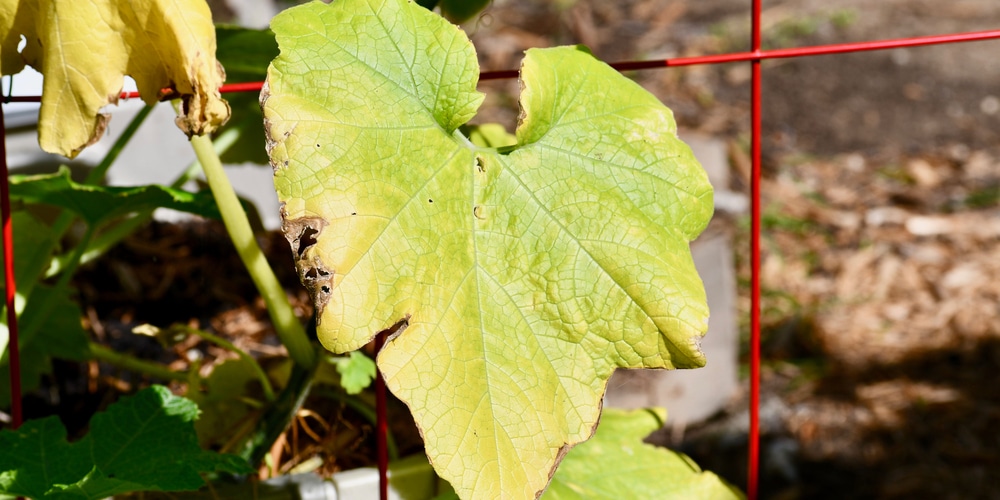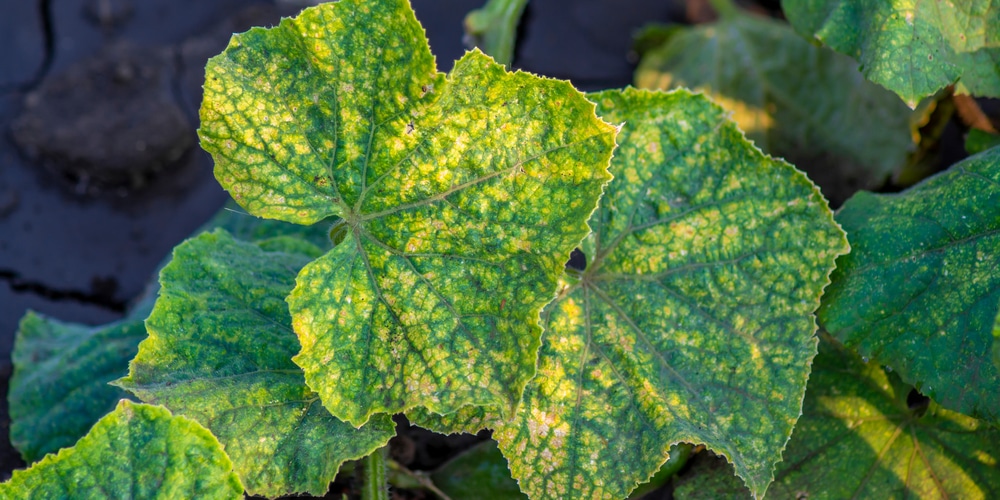Cucumbers are among the most popular vegetables eaten worldwide. But for those who grow them in their garden, it can be tricky figuring out why are my cucumber leaves turning yellow. Yellowing in cucumber leaves can be caused by several different problems, such as nutrient deficiencies, water shortages, or pest infestation.
However, identifying these issues isn’t important when it comes down to it because there are plenty of remedies for all the problems that don’t require extensive gardening knowledge.
Why Are My Cucumber Leaves Turning Yellow?

The leaves of cucumbers may turn yellow for several reasons. The most common is an imbalance in nitrogen and potassium levels in the soil. When nitrogen is deficient, leaves turn yellow and eventually wither and die. Potassium is vital for plant health and helps regulate water uptake, so when potassium levels are low, leaves will also turn yellow.
Other reasons that cucumber leaves may turn yellow include pests or diseases such as aphids, spider mites, or cucumber mosaic virus. In some cases, too much sun or heat can also cause leaves to turn yellow. If you’re not sure what’s causing the problem, it’s best to consult with a local gardening expert or agricultural extension service.
Soil Problems
Cucumber plants need soil that contains nutrients that are readily available to grow healthy and strong without too many problems developing. Unfortunately, if your soil doesn’t have the necessary nutrients, neither will your cucumbers.
Following proper planting guidelines won’t matter much since you won’t have the minerals you need to keep your plants healthy. However, cucumbers can still grow in soil that’s lacking in proper nutrients, it just takes a lot longer, and they’ll likely be much weaker when they do finally start producing fruit.
Luckily identifying a nutrient deficiency isn’t too difficult for a landscape designer or experienced gardener because there are several key signs to look out for. Hence, you know what’s wrong right away.
For example, if leaves are yellowing from the tips inward, this means that sulfur is needed to restore chlorophyll levels, which will help prevent other nutrients from being lost through the plant’s root system.
If, however, yellowing starts near the bottom of the leaf and works its way up until only veins remain green, then it’s likely that nitrogen is the issue. Nitrogen deficiencies are easily fixed with a little bit of organic matter sprinkled throughout your soil or composted manure if you have some on hand.
However, even without knowing precisely what nutrient deficiency your cucumber plant has, there are plenty of other ways to maintain healthy soil, so all nutrients are readily available for both short and long-term growth.
For example, if calcium, magnesium, or potassium is needed, then adding eggshells to the ground around your cucumber plants can provide these minerals in due time. However, since eggshells take quite a while to break down, this method may need to be used with another strategy when managing existing problems.
Fungus Issues
If fungus gnats keep appearing when you water your plants, or if it takes a long time for water to soak into the soil, then you’ll need to improve drainage so all plants, not just cucumbers, can grow their best.
This means altering your planting strategy and adjusting how you care for your plants, there isn’t any standing water, and cucumber leaves don’t get wet after a rainstorm.
Easy ways of doing this include leaving more room between each seedling to allow airflow and cultivating the ground around them less often since burying seeds too deeply can cause problems with root development.
Water Problems
When growing healthy cucumber plants, water shortages aren’t as common as nutrient deficiencies. But they still come up in greenhouses and other controlled growing environments from time to time.
Luckily cucumbers have a very shallow root system, so if water is scarce, then roots will quickly search for moisture rather than going deeper into the ground where they aren’t helpful.
If you notice that leaves are turning yellow from the base of them upward, it’s because cucumber plants need at least one inch of water per week to survive. This can be difficult when conditions outside are dry, but making sure the ground is moist every five to seven days should help your plants thrive.
With this, provided you’re regularly planting new seeds or moving more mature cucumbers along down rows since more significant food breaks up the soil too much and stops it from retaining moisture.
However, if there isn’t enough rainfall to get your cucumbers the water they need, you’ll want to start watering them yourself, but not while leaves are wet since this can also be a problem.
Instead of trying to keep plants damp all day long, so there’s always moisture around roots, cover the soil with mulch and give each seedling one inch of water every three days.
Pest Problems
When managing cucumber plants, the most common pests include aphids, beetles, cutworms, mites, and slugs. And while many of these will likely cause some damage to leaves early on, if they aren’t dealt with promptly, then your harvest will become smaller and more sparse as time goes on.
It’s essential to keep an eye on cucumber leaves for any of these pests and intervene immediately if you notice a single one even before their population starts to grow.
If aphids are the issue, then handpicking them off plants can be enough to eliminate them. However, sometimes an infestation becomes so large that it’s impossible to get every single bug without spending all day doing it.
In this case, neem oil will kill both adult and juvenile aphids while keeping ladybugs, beneficial wasps, and other insects from being harmed. Since neem oil is a natural pesticide, it is a great organic option for people who prefer not to use harsh chemicals when managing pests in their vegetable garden.
And speaking of natural pesticides, even if bugs aren’t the problem, powdery mildew and other fungal diseases can cause cucumber leaves to turn yellow.
But since both tend to come up in the same conditions as pests like aphids and beetles, it’s crucial not to waste time and money buying treatments that don’t work if you don’t even know what kind of pest is causing trouble.
Instead, try checking your plants every day for any signs of insects before applying any chemicals at all because this will be frequent enough.
Sunlight Problems
If your cucumber plant doesn’t get enough sunlight, its stems may twist and turn to find sun rays while the fruit itself stays green but doesn’t grow properly. Leaves might also turn yellow, wilt, and fall off without sunlight.
If you’re trying to get cucumbers to grow in an area that doesn’t have enough sun during the day, there are a couple of options for you. First, you can try supplementing with LED grow lights. Second, if possible, try planting your cucumber plants near a window so they can soak up some rays from the sun during the day.
How to Identify Mineral Deficiencies in Cucumbers?
A lack of magnesium in the soil causes cucumber plants to have yellow leaves since this mineral is essential for photosynthesis. Plants convert sunlight into energy to take place to thrive and produce fruit. Another mineral to consider supplementing with is zinc, as it helps regulate and balance plant hormones and enzymes so they function correctly.
If you don’t know how to identify a magnesium or zinc deficiency, there’s no need for concern because these minerals should be readily available in soil and fertilizers at your local garden store.
What to Do With Yellow Cucumber Leaves?
First things first: as soon as possible, cut off any leaves showing the signs of cucumber mosaic virus; otherwise, those plants could spread the disease to other healthy cucumbers nearby and possibly other fruits and veggies.
Now that we’ve got that out of the way, what do you want to do after identifying a nutrient deficiency on whether or not it was caused by over or under-watering, pests, or lack of sunlight?
Don’t worry if you can’t figure out the exact cause. The symptoms for each are very similar, and not identifying the reason doesn’t matter as long as you know what to do next.
Since your cucumber leaves were losing moisture fast enough that they started showing signs of wilting despite proper watering practices, then it’s likely that you’ll need to cut back on how many times a week you water your plants so they can retain their strength.
Cucumbers require moist but not soggy soil to thrive, so check on your soil weekly before flipping on the sprinkler or hose to ensure there aren’t any problems with drainage.
Lastly, if a lack of sunlight causes the problem, you’ll need to move your cucumber plants so they can soak up as much sun as possible before too many leaves start turning yellow. If that isn’t an option, there are several other ways to supplement additional light. Either try using grow lights or switching your plants into a part of the yard that has more sun hours each day.
Why Are My Cucumber Leaves Turning Yellow?: Conclusion
And that’s it! Knowing what causes leaves to turn yellow on cucumbers can help you figure out what needs improving to fix these problems without wasting money on products that won’t do anything or using more fertilizer than necessary.
Meaning that whenever this happens, remember: If the problem isn’t too serious, your cucumber plants can still recover without too much effort. And that’s it!

